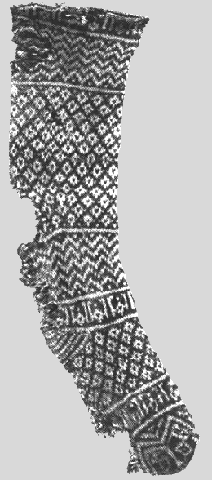Theories of Development
Knitted objects have been traditionaly utilitarian rather than decorative. Add to that fact that these objects were created from natural fibers that decay quickly in the most optimal environments and it is easy to understand why historical examples of the craft are extremely rare. There is also no documentation to be refered to. As a result much of the early origins of the craft consist of theories and guesswork. The oldest existing example is a pair of socks found in the Indus Valley and date back thousands of years. Another ancient example was found in Egypt and dated somewhere between the 3rd and 5th centuries. It is largely beleived that both of these examples are not a truely knitting but rather of a craft called nailbinding which may be a precursor to knitting as we know it today. Nailbinding produces a fabric very similar to knitting, but is created using one needle to produce a series of knots and woven loops.
 The oldest actual knitting found is "Coptic socks" from Egypt, dating to around the year 1000 CE. There are quite a few fragments, all of them done in shades of white and indigo. Many of them have Khufic (a decorative Arabic script) blessings knit into them, or symbols to ward off evil, or both. These examples have caused many experts to theorize that knitting is actualy much older than first thought, given the complexity of the designs that exist within these fragments. It would obviously take some time to reach this level of design intricacy and skill.
The oldest actual knitting found is "Coptic socks" from Egypt, dating to around the year 1000 CE. There are quite a few fragments, all of them done in shades of white and indigo. Many of them have Khufic (a decorative Arabic script) blessings knit into them, or symbols to ward off evil, or both. These examples have caused many experts to theorize that knitting is actualy much older than first thought, given the complexity of the designs that exist within these fragments. It would obviously take some time to reach this level of design intricacy and skill.
The next examples were found in a tomb that was sealed in 1275 and originated in Arab occupied Spain. In the tomb were found sock fragments and a knitted cusion, all of which contained decorative Arabic script worked into the pieces. It is interesting to consider the fact that these pieces date to the very heart of the Dark Ages where the vast majority of the poulation in Europe was illiterate while at the same time literacy was widespread among the Islamic cultures. Many historians attribute the origin of knitting to the European areas, but this evidence makes a strong argument to the contrary. Another piece of possible evidence is the way that knitting is accomplished from right to left. European languages are written and read from left to right, but Arabic languages are opposite, from right to left!




